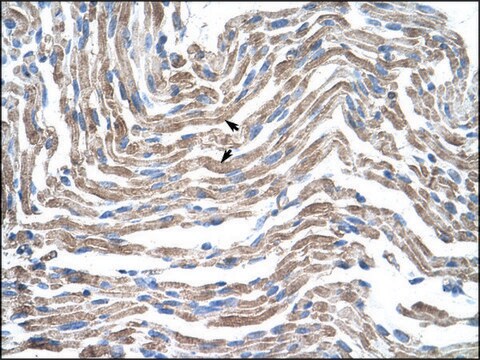MABN2719
Anti-Neurofilament M/NEFM Antibody, clone 2H3
Synonim(y):
160 kDa neurofilament protein, NF-M, Neurofilament 3, Neurofilament medium polypeptide, Neurofilament triplet M protein
About This Item
Polecane produkty
pochodzenie biologiczne
mouse
Poziom jakości
forma przeciwciała
purified antibody
rodzaj przeciwciała
primary antibodies
klon
2H3, monoclonal
masa cząsteczkowa
calculated mol wt 96 kDa
observed mol wt ~160 kDa
oczyszczone przez
using protein G
reaktywność gatunkowa
rat, human, mouse
opakowanie
antibody small pack of 100
metody
immunocytochemistry: suitable
immunofluorescence: suitable
immunohistochemistry: suitable
western blot: suitable
izotyp
IgG1κ
sekwencja epitopowa
Unknown
numer dostępu Protein ID
numer dostępu UniProt
temp. przechowywania
2-8°C
informacje o genach
rat ... Nefm(24588)
Specyficzność
Immunogen
Zastosowanie
Evaluated by Western Blotting in Rat brain tissue extracts.
Western Blotting Analysis: A 1:500 dilution of this antibody detected Neurofilament medium polypeptide (NF-M) in Rat brain tissue extract.
Tested Applications
Western Blotting Analysis: A 1:500 dilution from a representative lot detected Neurofilament medium polypeptide (NF-M) in mouse brain tissue extract.
Immunohistochemistry Applications: A representative lot detected Neurofilament medium polypeptide (NF-M) in Immunohistochemistry applications (Clugston, R.D., et al. (2010). Am J Respir Cell Mol Biol. 42(3):276-85; Lysakowski, A., et al. (2011). J Neurosci. 31(27):10101-14; Kridsada, K., et al. (2018). Cell Rep. 23(10):2928-2941; Latremoliere, A., et al. (2018). Cell Rep. 24(7):1865-1879.e.9).
Immunocytochemistry Analysis: A representative lot detected Neurofilament medium polypeptide (NF-M) in Immunocytochemistry applications (Latremoliere, A., et al. (2018). Cell Rep. 24(7):1865-1879.e.9).
Immunofluorescence Analysis: A representative lot detected Neurofilament medium polypeptide (NF-M) in Immunofluorescence applications (Latremoliere, A., et al. (2018). Cell Rep. 24(7):1865-1879.e.9).
Western Blotting Analysis: A representative lot detected Neurofilament medium polypeptide (NF-M) in Western Blotting applications (Fernandez-Cerado, C., et al. (2021). J Neural Transm (Vienna). 128(4):575-587).
Note: Actual optimal working dilutions must be determined by end user as specimens, and experimental conditions may vary with the end user.
Opis wartości docelowych
Postać fizyczna
Rekonstytucja
Przechowywanie i stabilność
Inne uwagi
Oświadczenie o zrzeczeniu się odpowiedzialności
Not finding the right product?
Try our Narzędzie selektora produktów.
Kod klasy składowania
12 - Non Combustible Liquids
Klasa zagrożenia wodnego (WGK)
WGK 1
Temperatura zapłonu (°F)
Not applicable
Temperatura zapłonu (°C)
Not applicable
Certyfikaty analizy (CoA)
Poszukaj Certyfikaty analizy (CoA), wpisując numer partii/serii produktów. Numery serii i partii można znaleźć na etykiecie produktu po słowach „seria” lub „partia”.
Masz już ten produkt?
Dokumenty związane z niedawno zakupionymi produktami zostały zamieszczone w Bibliotece dokumentów.
Nasz zespół naukowców ma doświadczenie we wszystkich obszarach badań, w tym w naukach przyrodniczych, materiałoznawstwie, syntezie chemicznej, chromatografii, analityce i wielu innych dziedzinach.
Skontaktuj się z zespołem ds. pomocy technicznej








